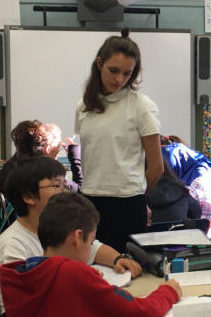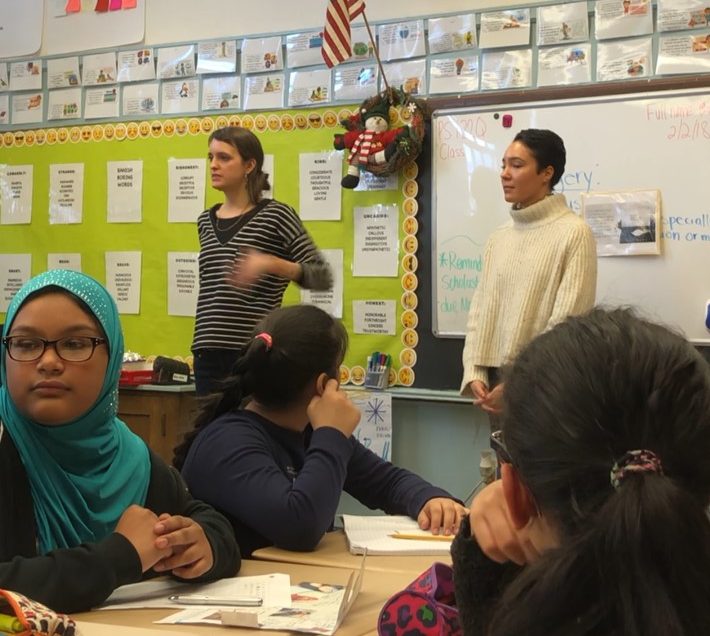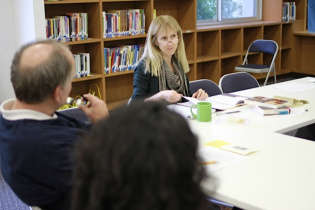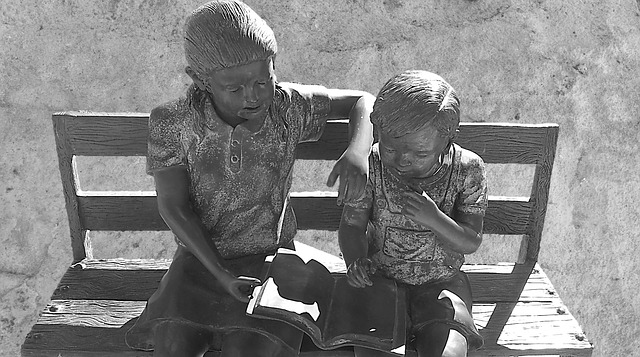By Olaya Barr and India Gonzalez
The two of us have been co-teaching sixth-graders at PS 122, Mamie Fay in Queens, for the past six months. During this time we have learned a great deal about ourselves as individual teachers and as a pair. Because of this, we thought it would be beneficial to present other co-teachers with tips that have helped us flourish in our partnership. Here are the five main pieces of advice we came up with!
1) Respect Your Differences:
Understand and appreciate that you are two people, which means different approaches, ideas, and strengths and weaknesses.
With any teaching partnership, you will start to note and understand the differences between you and your colleague over time. The key is being able to respect and support those dissimilarities. As a team, you should capitalize on your different approaches and personalities to complement one another. It can be a wonderful experience having two minds in the room instead of one; this leads to richer and more creative ways of engaging with your students.

A great way to think of co-teaching is like comedy improvisation, where the number one rule is that no matter what happens, you always respond, “Yes, and…” With co-teaching, this doesn’t mean that you will always agree with your partner, or that you don’t speak up if you want to change how something is going, but rather that you keep an open mind. Co-teaching should be planned out appropriately, but will almost always require a bit of spontaneity and on-the-spot problem solving. Saying “Yes, and…” figuratively means regarding and supporting your co-teacher’s decisions, even if they differ from your natural instincts.
Also, milk your differences. If one of you is better with high-energy kids, and the other is naturally a shyer individual, use that! Some kids will naturally gravitate to a more theatrical teacher, while others will feel more comfortable with a quiet one-on-one relationship. If one of you has stronger poetry know-how and the other is more well-read in contemporary fiction, don’t ignore it, use it! There’s nothing embarrassing about having your students witness your differences.
2) Clarify Your Roles:
After you’ve explored what your differences are, you’re positioned to figure out your respective roles. What are your different creative strengths? What aspects of instruction are you most comfortable with?
It is important that you prescribe roles and structure how you behave in the classroom. This way, your students know who is in charge of what and who leads which activity. The tough part is that it usually takes working together in a classroom to illuminate who is better at what role. That being said, you can still take authority in the beginning and decide, “I’m comfortable with facilitating writing, and you’re better at analyzing texts in an accessible way. So I’ll be the creative writer in the classroom, and you be the creative reader.” If in every class one person is reliably guiding the reading and one person is always introducing the writing exercise, for example, the students know whom to look to for what. When a student doesn’t understand a metaphor in the text we’re reading in class, they know to ask India. Or if a student is struggling to write a believable character, they’ll ask Olaya for help. This divide-and-conquer technique seems to have made us more relatable. We’re not one bland amorphous duo; we’re two people, with separate strengths.
A great way to clarify your roles is to have a meeting and ask each other, what kind of teacher are you? What are you excellent at in the classroom? What area(s) do you need to improve? From there, you can establish who is better suited to do what. It may also help to know what your co-teacher’s experiences are with children and teaching before you go into a partnership. If you have experience working with kids with special needs, for example, there’s a good chance you know how to integrate visual vocabulary or multisensory instruction; or if your prior experience is with college students, you are probably better at giving one-on-one workshop critiques, or asking demanding reading questions.
3) Communicate:
Explicit communication practices are key. How will you plan together? How will you disagree in front of the students?
Communication is major in any and every relationship. We know that always having the lines of communication open and properly expressing yourself can be a bit exhausting at times, but it is of the utmost importance when we are teaching together. When planning lessons we work on Google Docs so that we can both make edits (even at the same time on occasion!). We will chat on the Google Doc, call each other, email, and text throughout the week. It makes for a better lesson when you’ve articulated and agreed on a game plan. It’s better to over-explain your thoughts than to give the abbreviated version and assume your co-teacher is on the same wavelength. Sometimes we will hop on the phone after emailing back and forth to make final decisions and talk through everything we’ve thought out. When you’re teaching solo you don’t necessarily have to walk/talk through every step of your lesson because you’re storing it all in your head—this can be a disadvantage at times! Saying it out loud really helps smooth out the kinks.

The way you communicate with one another in front of the students is also incredibly important. It serves as a wonderful learning opportunity to show students how two people can collaborate. Whether it’s asking your partner what they think about something you’ve just shared with the class or disagreeing slightly, these are great moments to show productive ways of interacting. If you react differently to a situation with a student in front of the class, that’s potentially valuable. You can move past it, or laugh it off; you can even call attention to it, let the kids know, “Oh well, I guess we have differing opinions on this!” This way they can see an adult way of disagreeing that doesn’t lead to argumentation. Check in with each other (either in private or in front of the class, however you see fit), remain flexible, and you will come to a shared conclusion in the end. Or if you want to offer a contrasting opinion from what your co-teacher has just said, make sure the language you use isn’t accusatory. You can state, sincerely of course, that you had a different take and would like to add your point of view to the class discussion, as you think it may be beneficial. This can in turn encourage students to speak up and not be afraid to add their voices to the mix. It’s also important to use positive language when passing the torch to a co-teacher. Even if it’s saying something cheesy like, “I think our wonderful poetry-ninja can talk more about why imagery is super important…” The kids perk up when they see that we get along and defer to one another’s expertise.
4) Get Inspired:
What can you learn from your partner? How do you make that learning intentional?
Co-teaching can be a wonderful source of inspiration where you can pick up positive traits from your partner and apply them to your own teaching. We are always watching each other teach and seeing what lands with our students and what doesn’t. We also share anecdotes after class, which is very helpful. Maybe you notice your co-teacher acting out part of a poem, or using a different voice to read dialogue, and the students respond to it positively. Try it out during the next workshop and see how it feels! The next step to observing is to note, in your head, in a journal, or even in another Google Doc, certain teaching pedagogies or personality traits that you have noticed in your partner that you may lack, but find admirable.
Getting inspired is not only about observing your co-teacher, but also observing your students. If one of your students, for example, writes a story specifically about being biracial, one of the co-teachers might be better suited to give a thoughtful response than another based on their personal experiences. Or if one of your students is getting frustrated with writer’s block or is too shy to read their work aloud, one co-teacher may be better at luring out the performer. There’s nothing wrong with admitting these differences!
Because we come from different parts of the US, have traveled to different places, write in different forms (poetry and prose), and are, simply put, different people, we read texts and approach tasks in writing— like creating an unreliable narrator, or figuring out where to insert line breaks—differently. This is the factor that makes teaching writing with a partner so fun and surprising. It’s almost like going through another MFA program!
5) Reflect:
What are the advantages of having someone witness you? How do you validate one another and give and request feedback? How does that impact your teaching?
At the end of every session we walk to the train together, and in that time we discuss how we felt the classes went. What text really spoke to our students? How did different classes react? What can we tweak to make our lesson plan better the next time? How did we handle certain instances with the children? We also offer each other positive reinforcement by saying, “I really liked when you did such and such today.” We even laugh over not-so-great happenings that we can improve upon the next time around. There is a lot you can gain from having someone witness you in class, as they can draw attention to certain aspects of your teaching that you weren’t aware of. Once you start to feel comfortable with one another, you can even request feedback and ask questions about how something went in class that you weren’t so sure about. Ideally, the reflection feels intuitive and organic. But if not, you can also send a text or email after class to share brief thoughts about how everything went. Having this moment to check in and be honest with one another is one of the perks of co-teaching, because it can improve your instruction and give you a new perspective.
Every co-teaching partnership will have different dynamics, strengths, and issues that arise, but we hope these tips can serve as basic guidelines for how to interact positively with one another and gain as much out of the experience as possible. It is such a plus to have another teacher to collaborate with in every aspect of teaching, from lesson plans to dealing with students in the classroom. Every element receives double the attention and double the care. You just have to find your groove as a pair, and as we said before, milk it!
About the Authors:
Olaya Barr is a writer, translator, photographer, and T&W teaching artist. India Gonzalez is a graduate student at New York University and a 2017–2018 T&W education associate.



